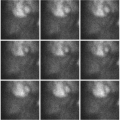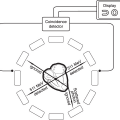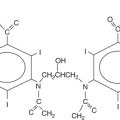Indication |
Appropriateness
Criteria
(Median Score) |
|---|
Detection of CAD): Symptomatic—
Evaluation’ of Chest Pain Syndrome |
3. |
• Intermediate pre-test probability of CAD
• ECG interpretable AND able to exercise |
A (7.0) |
4. |
• Intermediate pre-test probability of CAD
• ECG uninterpretable OR unable to exercise |
A (9.0) |
5. |
• High pre-test probability of CAD
• ECG interpretable AND able to exercise |
A (8.0) |
6. |
• High pre-test probability of CAD
• ECG uninterpretable OR unable to exercise |
A (9.0) |
Detection of CAD: Symptomatic—
Acute Chest Pain (in Reference to Rest Perfusion Imaging) |
7. |
• Intermediate pre-test probability of CAD
• ECG: no ST elevation AND initial cardiac enzymes negative |
A (9.0) |
Detection of CAD: Symptomatic—
New-Onset/Diagnosed Heart Failure With Chest Pain Syndrome |
9. |
• Intermediate pre-test probability of CAD |
A (8.0) |
Detection of CAD: Asymptomatic—
New-Onset or Diagnosed Heart Failure of LV Systolic Dysfunction
Without Chest Pain Syndrome |
12. |
• Moderate CHD risk (Framingham)
• No prior CAD evaluation AND no planned cardiac catheterization |
A (7.5) |
Detection of CAD: Asymptomatic (Without Chest Pain Syndrome)—
New-Onset Atrial Fibrillation |
15. |
• High CHD Risk (Framingham)
• Part of the evaluation |
A (8.0) |
Detection of CAD: Asymptomatic (Without Chest Pain Syndrome)—
Ventricular Tachycardia |
16. |
• Moderate to high CHD risk (Framingham) |
A (9.0) |
Risk Assessment: General and Specific Patient Populations—
Asymptomatic |
19. |
• Moderate to high CHD risk (Framingham)
• High-risk occupation (e.g., airline pilot) |
A (8.0) |
20. |
• High CHD risk (Framingham) |
A (7.5) |
Risk Assessment With Prior Test Results: Asymptomatic OR Stable Symptoms—
Normal Prior SPECT MPI Study |
22. |
• Normal initial RNI study
• High CHD risk (Framingham)
• Repeat SPECT MPI study after 2 years or greater |
A (7.0) |
Risk Assessment With Prior Test Results: Asymptomatic OR Stable Symptoms—
Abnormal Catheterization or Prior SPECT MPI Study |
24. |
• Known CAD on catheterization OR prior SPECT MPI
study in patients who have not had revascularization
procedure
• Greater than or equal to 2 years to evaluate worsening disease |
A (7.5) |
Risk Assessment With Prior Test Results: Worsening Symptoms—
Abnormal Catheterization OR Prior SPECT MPI Study |
25. |
• Known CAD on catheterization OR prior SPECT MPI study |
A (9.0) |
Risk Assessment With Prior Test Results: Asymptomatic—
Prior Coronary Calcium Agatston Score |
27. |
• Agatston score greater that or equal to 400 |
A (7.5) |
Risk Assessment With Prior Test Results: UA/NSTEMI, STEMI,
or Chest Pain Syndrome—Coronary Angiogram |
29. |
• Stenosis of unclear significance |
A (9.0) |
Risk Assessment With Prior Test Results—
Duke Treadmill Score |
30. |
• Intermediate Duke treadmill score
• Intermediate CHD risk (Framingham) |
A (9.0) |
Risk Assessment: Preoperative Evaluation for Noncardiac Surgery—
Intermediate-Risk Surgery |
33. |
• Intermediate perioperative risk predictor OR
• Poor exercise tolerance (less than 4 METS) |
A (8.0) |
Risk Assessment: Preoperative Evaluation for Noncardiac Surgery—
High-Risk Surgery |
35. |
• Minor perioperative risk predictor AND
• Poor exercise tolerance (less than 4 METS) |
A (8.0) |
Risk Assessment: Following Acute Coronary Syndrome—
STEMI-Hemodynamically Stable |
37. |
• Thrombolytic therapy administered
• Not planning to undergo catheterization |
A(8.0) |
Risk Assessment: Following Acute Coronary Syndrome—
UA/NSTEMI—No Recurrent Ischemia OR No Signs of HF |
39. |
• Not planning to undergo early catheterization |
A(8.5) |
Risk Assessment: Post-Revascularization (PCI or CABG)—
Symptomatic |
41. |
• Evaluation of chest pain syndrome |
A(8.0) |
Risk Assessment: Post-Revascularization (PCI or CABG)—
Asymptomatic |
44. |
• Asymptomatic prior to previous revascularization
• Greater than or equal to 5 years after CABG |
A(7.5) |
45. |
• Symptomatic prior to previous revascularization
• Greater than or equal to 5 years after CABG |
A(7.5) |
Assessment of Viability/Ischemia: Ischemic Cardiomyopathy
(Includes SPECT Imaging for Wall Motion and Ventricular Function) |
50. |
• Known CAD on catheterization
• Patient eligible for revascularization |
A(8.5) |
Evaluation of Left Ventricular Function |
51. |
• Non-diagnostic echocardiogram |
A (9.0) |
Evaluation of Ventricular Function:
Use of Potentially Cardiotoxic Therapy (e.g., Doxorubicin) |
52. |
• Baseline and serial measurement |
A (9.0) |
A, (Appropriate); CAD, coronary artery disease; CHD, coronary heart disease; ECG, electrocardiogram; I, (Inappropriate); LV, left ventricular; METS, metabolic equivalents; PCI, percutaneous coronary intervention; RNI, radionuclide imaging; STEMI, ST-elevation myocardial infarction; U, (Uncertain); UA/NSTEMI, unstable angina/non–ST-elevation myocardial infarction |
Reprinted from Brindis RG, Douglas PS, Hendel RC, et al. ACCF/ASNC appropriateness criteria for single-photon emission computed tomography myocardial perfusion imaging (SPECT MPI): a report of the American College of Cardiology Foundation Quality Strategic Directions Committee Appropriateness Criteria Working Group and the American Society of Nuclear Cardiology endorsed by the American Heart Association. J Am Coll Cardiol. 2005; 46:1587–1605, with permission from Elsevier. |







